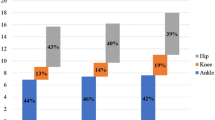Abstract
Purpose
In total knee arthroplasty (TKA), dynamic knee loading may loosen the artificial joint and bone or cause polyethylene wear after prolonged use. TKA decreases knee adduction moment at 6 months, but this effect is lost by 1 year post-operatively. However, lateral thrust after TKA has not been clarified. We hypothesized that like knee adduction moment, lateral thrust would return to baseline levels by 1 year post-operatively.
Methods
Participants were 15 patients who underwent TKA for medial knee OA. Japanese Orthopaedic Association (JOA) score, numeric rating scale, and gait analysis (measurement of peak knee adduction moment, knee varus angle at peak knee adduction moment, lateral thrust, and gait speed) were performed preoperatively (baseline) and 3 weeks, 3 and 6 months, and 1 year post-operatively.
Results
JOA score improved from 55 ± 9.8 to 78 ± 12.1 at 1 year post-operatively, and pain decreased significantly from baseline at each follow-up (p < 0.001). Significant increases in gait speed were observed at 6 months and 1 year (p < 0.001). Peak knee adduction moment during stance phase was significantly lower at 3 weeks, 3 months, and 6 months compared to baseline (p < 0.05), but no significant changes were seen at 1 year. Knee varus at peak knee adduction moment did not differ significantly between any measurement points, while lateral thrust was decreased at 6 months and 1 year compared to baseline (p < 0.05).
Conclusions
Temporal courses of changes up to 1 year after TKA differed between knee adduction moment and lateral thrust, so our hypothesis was rejected.
Level of evidence
IV.




Similar content being viewed by others
References
Jackson BD, Wluka AE, Teichtahl AJ, Morris ME, Cicuttini FM (2004) Reviewing knee osteoarthritis—a biomechanical perspective. J Sci Med Sport 7:347–357
Maly MR (2008) Abnormal and cumulative loading in knee osteoarthritis. Curr Opin Rheumatol 20:547–552
Chang A, Hayes K, Dunlop D, Hurwitz D, Song J, Cahue S, Genge R, Sharma L (2004) Thrust during ambulation and the progression of knee osteoarthritis. Arthritis Rheum 50:3897–3903
Manal K, Buchanan TS (2013) An electromyogram-driven musculoskeletal model of the knee to predict in vivo joint contact forces during normal and novel gait patterns. J Biomech Eng 135:021014
Orishimo KF, Kremenic IJ, Deshmukh AJ, Nicholas SJ, Rodriguez JA (2011) Does total knee arthroplasty change frontal plane knee biomechanics during gait? Clin Orthop Relat Res 470:1171–1176
Kellgren JH, Lawrence JS (1957) Radiological assessment of osteo-arthrosis. Ann Rheum Dis 16:494–502
Koshino T (1998) Japanese Orthopaedic Association knee scoring system. J Jpn Orthop Assoc 62:900–902
Hartrick CT, Kovan JP, Shapiro S (2003) The numeric rating scale for clinical pain measurement: a ratio measure? Pain Pract 3:310–316
Davis RB, Ounpuu S, Tyburski D, Gage JR (1991) A gait analysis data collection and reduction technique. Hum Mov Sci 10:575–587
Kuroyanagi Y, Nagura T, Kiriyama Y, Matsumoto H, Otani T, Toyama Y, Suda Y (2011) A quantitative assessment of varus thrust in patients with medial knee osteoarthritis. Knee 19:130–134
Hunt MA, Birmingham TB, Giffin JR, Jenkyn TR (2006) Associations among knee adduction moment, frontal plane ground reaction force, and lever arm during walking in patients with knee osteoarthritis. J Biomech 39:2213–2220
Andriacchi TP, Mundermann A, Smith RL, Alexander EJ, Dyrby CO, Koo S (2004) A framework for the in vivo pathomechanics of osteoarthritis at the knee. Ann Biomed Eng 32:447–457
Hurwitz DE, Ryals AB, Case JP, Block JA, Andriacchi TP (2002) The knee adduction moment during gait in subjects with knee osteoarthritis is more closely correlated with static alignment than radiographic disease severity, toe out angle and pain. J Orthop Res 20:101–107
Lind M, McClelland J, Wittwer JE, Whitehead TS, Feller JA, Webster KE (2013) Gait analysis of waling before and after medial opening wedge high tibial osteotomy. Knee Surg Sports Traumatol Arthrosc 21:74–81
Robbins SM, Maly MR (2009) The effect of gait speed on the knee adduction moment depends on waveform summary measures. Gait Posture 30:543–546
Kettelkamp DB, Johnson RJ, Smidt GL, Chao EY, Walker M (1970) An electrogoniometric study of knee motion in normal gait. J Bone Joint Surg Am 52:775–790
Takigami H (1998) Lateral thrust of osteoarthritic knee with relation to clinical signs and symptoms. J Yokohama Med J 49:505–510
Murphy M, Journeaux S, Russell T (2009) High-flexion total knee arthroplasty: a systematic review. Int Orthop 33:887–893
Dattani R, Patnaik S, Kantak A, Tselentakis G (2009) Navigation knee replacement. Int Orthop 33:7–10
Wylde V, Dieppe P, Hewlett S, Learmonth ID (2007) Total knee replacement: is it really an effective procedure for all? Knee 14:417–423
Frimenko R, Goodyear C, Bruening D (2015) Interactions of sex and aging on spatiotemporal metrics in non-pathological gait: a descriptive meta-analysis. Physiotherapy. doi:10.1016/j.physio.2015.01.003
Acknowledgments
We wish to thank all Hiroshima University Hospital Orthopedic Surgery staff for their assistance in our study.
Author information
Authors and Affiliations
Corresponding author
Ethics declarations
Conflict of interest
There are no conflicts of interest to declare.
Rights and permissions
About this article
Cite this article
Shimada, N., Deie, M., Hirata, K. et al. Courses of change in knee adduction moment and lateral thrust differ up to 1 year after TKA. Knee Surg Sports Traumatol Arthrosc 24, 2506–2511 (2016). https://doi.org/10.1007/s00167-015-3688-3
Received:
Accepted:
Published:
Issue Date:
DOI: https://doi.org/10.1007/s00167-015-3688-3




